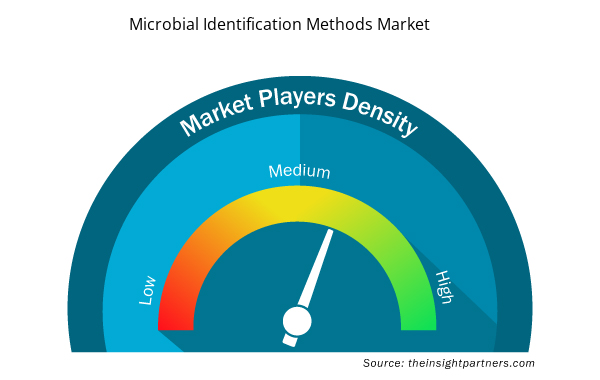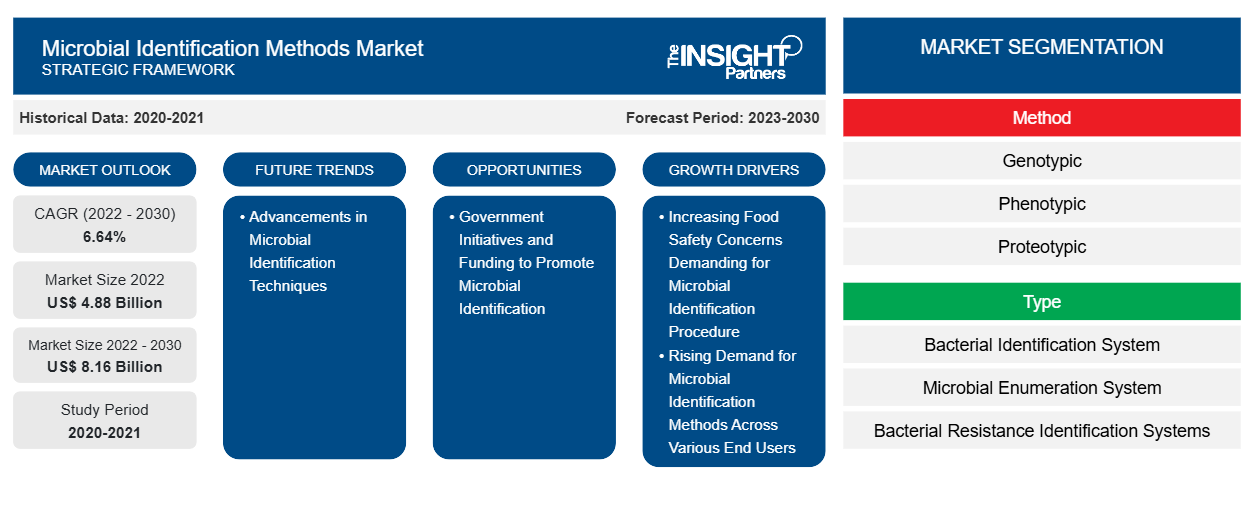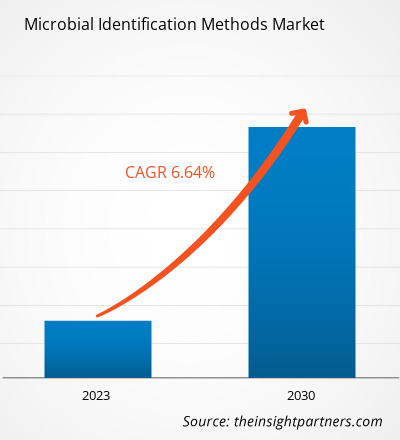[調査レポート] 微生物識別方法の市場規模は、2022年の48億8,285万米ドルから成長し、2030年までに81億6,474万米ドルに達すると予想されており、2022年から2030年にかけて6.64%のCAGRを記録すると予想されています。
市場洞察とアナリストの見解:
微生物は、遺伝子型、プロテオタイプ、表現型の 3 つの主な手法で識別できます。微生物識別方法の成長を牽引する主な要因は、食品の安全性に対する懸念が高まり、微生物識別手順が求められることと、さまざまなエンド ユーザーの間で微生物識別方法に対する需要が高まっていることです。ただし、自動化された微生物識別システムの高コストと、複雑な規制枠組みによる新しい微生物診断テストの承認プロセスの遅延により、微生物識別方法市場の成長が妨げられています。
成長の原動力と制約:
食中毒は、蔓延し拡大している公衆衛生および経済問題です。食中毒の蔓延は、食品の生産および加工方法の最近の変化と、消費者の食習慣の変化の影響を受けています。感染中の既知の病原体間の相互作用は懸念事項の 1 つであり、近年新たな問題が浮上しています。化学保存料の採用の増加、コールド チェーン、微生物に関する理解の深まりにもかかわらず、食中毒は先進国と発展途上国の両方にとって重大な公衆衛生問題です。食品安全クラスターは、毎年約42万人が死亡し、6億人以上(全世界で約10人に1人)が汚染された食品を摂取した後に病気になり、2022年6月には3,300万DALYの損失が発生していると推定しています。欧州食品安全機関(EFSA)と欧州疾病予防管理センター(ECDC)によると、2021年にヨーロッパで4,005件の食中毒が発生し、2020年と比較して29.8%増加しています。報告された感染の発生のほとんどは、サルモネラ菌、カンピロバクター、細菌毒素、ウイルスが原因でした。食品の品質を維持し、消費者の安全を保証するには、複雑な食品マトリックス中の食中毒病原体、腐敗微生物、その他の生物学的汚染物質を迅速に検出することが重要です。従来のアプローチは、さまざまな非選択的および選択的濃縮技術を使用して細菌を培養し、その後に生化学的確認を行うことです。食品、特に生肉、魚、乳製品、野菜などの賞味期限の短い食品を検査する場合、検出までの時間は大きな制約となります。いくつかの新しい検出方法では、マトリックス支援レーザー脱離イオン化飛行時間やハイパースペクトル画像化プロトコルなどの分光法が使用されています。そのため、食中毒の症例の増加が微生物識別方法市場を牽引しています。
微生物同定法市場は、さまざまなエンドユーザーの間で微生物同定法に対する需要が高まっていることによってさらに推進されています。製薬、バイオテクノロジー、食品・飲料、診断など、さまざまな業界で微生物同定製品の需要が高まっています。たとえば、Charles River Laboratories は、微生物同定および株タイピング サービスを通じて年間 620,000 を超える環境分離株を処理し、世界中の QC ラボから頻繁に回収される実際のサンプルに基づいて生物ライブラリを拡大しています。この需要の増加は、研究の品質、安全性、進歩を保証する上で微生物同定が果たす重要な役割を強調する要素の合流によって促進されています。製薬およびバイオテクノロジーの分野では、厳格な規制要件により、医薬品製造プロセスの完全性を維持するために微生物を正確に識別する必要があります。さらに、製薬およびバイオテクノロジーでは、微生物同定製品は研究開発において重要な役割を果たし、科学者が治療および産業用途で微生物を理解して操作するのに役立ちます。食品・飲料業界では、微生物同定に対する需要も高まっています。消費者が食品の安全性と品質をますます意識するようになるにつれ、この分野の企業は、潜在的な汚染物質や腐敗菌を検出して軽減するためにこれらの方法に依存しています。これにより、安全で高品質の消耗品の生産が保証されるだけでなく、賞味期限の延長、廃棄物の削減、規制基準の遵守にも役立ちます。診断の分野では、微生物同定が医療の世界に革命をもたらしました。病原体をタイムリーかつ正確に特定することは、感染症の診断、治療の決定の指針、およびアウトブレイクの制御に不可欠です。分子技術と高度な微生物同定製品は、医療提供者と臨床検査室にとって不可欠なツールとなっています。これらの分野以外にも、微生物同定は環境モニタリング、水処理、研究、学術の分野で応用されています。さまざまな分野の研究者がこれらの製品に依存して、微生物生態系の複雑さを解明し、画期的な実験を実施し、科学の進歩に貢献しています。微生物同定製品は、技術の発展に伴い、より広く利用可能になり、効果的で、適応性が高くなっています。品質、安全性、科学の進歩に対する共通の献身により、さまざまなエンドユーザーカテゴリで微生物の人気の高まりが維持されると考えられます。これは、微生物の同定が多くの産業の方向性を決定し、世界中のコミュニティの健康を保証する上で果たす重要な役割を強調しています。
その一方で、自動微生物同定システムの高コストは、高度な微生物学技術への投資を検討している多くの研究室や機関にとって大きな課題となっています。これらのシステムには、迅速かつ正確な微生物の同定、手作業の削減、データ分析機能の強化など、数多くの利点があります。しかし、その高額な価格が導入の障壁となることも少なくありません。自動微生物同定システムの高コストの主たる理由は、組み込まれている複雑な技術です。これらのシステムは、微生物を正確に識別するために、洗練された機器、高度なアルゴリズム、特殊なデータベースを採用しています。研究開発と継続的なメンテナンスと更新が、初期費用と運用費用の高額化の一因となっています。自動微生物学的識別ツールは高額で、最先端の機能が備わっています。たとえば、MALDI-TOF ベースのシステムの価格は、約 150,000~850,000 米ドルです。MALDI-TOF-based system costs ~US$ 150,000–850,000.
要件に合わせてレポートをカスタマイズする
このレポートの一部、国レベルの分析、Excelデータパックなど、あらゆるレポートを無料でカスタマイズできます。また、スタートアップや大学向けのお得なオファーや割引もご利用いただけます。
- このレポートの主要な市場動向を入手してください。この無料サンプルには、市場動向から見積もりや予測に至るまでのデータ分析が含まれます。
レポートのセグメンテーションと範囲:
微生物識別方法市場は、方法別に、遺伝子型、表現型、およびプロテオタイプの3つに分類されています。表現型セグメントは、2022年に最大の市場シェアを占めました。遺伝子型セグメントは、2022年から2030年にかけて最高のCAGRを記録すると予想されています。微生物識別方法市場は、タイプ別に、細菌識別システム、微生物計数システム、細菌耐性識別システム、微生物分析装置、その他に分類されています。細菌識別システムセグメントは、2022年に最大の市場シェアを占め、2022年から2030年にかけて最高のCAGRを記録すると予想されています。
微生物識別方法市場は、地理に基づいて、北米(米国、カナダ、メキシコ)、欧州(ドイツ、フランス、イタリア、英国、ロシア、その他の欧州)、アジア太平洋(オーストラリア、中国、日本、インド、韓国、その他のアジア太平洋)、中東およびアフリカ(南アフリカ、サウジアラビア、UAE、その他の中東およびアフリカ)、ラテンアメリカ(ブラジル、メキシコ、その他のラテンアメリカ)に分類されています。
セグメント分析:
微生物識別方法市場は、方法別に、遺伝子型、表現型、およびプロテオタイプに分類されます。表現型セグメントは、2022年に最大の市場シェアを占めました。遺伝子型セグメントは、2022年から2030年の間に最高のCAGRを記録すると予想されています。表現型法は、微生物識別の「従来の」方法と呼ばれることがよくあります。微生物識別の表現型法は、種間の代謝変異を利用して微生物を識別します。この方法には通常、グラム染色、培養、および生化学アッセイが含まれます。表現型法では、さまざまなテストが実行され、その結果によって、識別が得られるまで可能なオプションが絞り込まれます。APIストリップ、FAME分析、およびVITEKは、よく知られている表現型テストの一部です。
微生物識別方法市場は、タイプ別に、細菌識別システム、微生物計数システム、細菌耐性識別システム、微生物分析装置、その他に分類されます。細菌識別システムセグメントは、2022年に最大の市場シェアを占め、2022年から2030年にかけて最高のCAGRを記録すると予想されています。
地域分析:
地理に基づいて、世界の微生物識別方法市場は、北米、ヨーロッパ、アジア太平洋、南米および中米、中東およびアフリカの5つの主要地域に分割されています。 2022年には、北米が世界の微生物識別方法市場規模の最大のシェアを占めました。 アジア太平洋地域は、2022年から2030年にかけて最高のCAGRを記録すると予測されています。 北米の微生物識別方法市場は、ヘルスケア、医薬品、食品および飲料、環境モニタリングなど、さまざまな業界で正確で迅速な微生物識別の需要が急増したため、過去数年間で大幅な成長を遂げています。 この成長は、感染症の発生率の上昇、食品および医薬品生産における厳格な品質管理措置の必要性、公衆衛生の維持における微生物モニタリングの重要性に対する認識の高まりなど、いくつかの要因に起因しています。 CDCの2022年11月の最新情報によると、冷凍ファラフェルに関連する大腸菌の発生により、20人が病気になり、5人が入院しました。さらに、技術の進歩、革新的な微生物同定方法の導入、および重要なプレーヤーの存在が、今後数年間の市場拡大を支えると予想されています。たとえば、微生物学の細菌同定テストの準備を自動化することを目的としたBD Kiestra IdentifAシステムは、2022年1月にFDAから510(k)承認を取得しました。さらに、米国を拠点とする組織であるBruker Corporationは、MALDI Biotyper CAシステムを使用して陽性血液培養から425を超える細菌を迅速に識別するMBT Sepsityper Kit IVDを2021年1月に発表しました。さらに、自動化と人工知能(AI)は、識別プロセスの合理化、人的エラーの削減、および全体的な効率の向上に極めて重要です。製薬およびバイオテクノロジー部門は、北米の微生物識別市場の成長に大きく貢献しています。医薬品開発、品質管理、および規制遵守のための微生物の正確な識別の必要性により、高度な識別方法に対する需要が高まっています。したがって、さまざまなエンドユーザーによる正確かつ迅速な微生物識別の需要の高まり、感染症の発生率の上昇、食品および医薬品の生産における厳格な品質管理措置の必要性、公衆衛生の維持における微生物モニタリングの重要性に対する認識の高まりは、北米の市場を牽引するその他のいくつかの要因です。
微生物同定方法市場の地域別洞察
予測期間を通じて微生物識別方法市場に影響を与える地域的な傾向と要因は、Insight Partners のアナリストによって徹底的に説明されています。このセクションでは、北米、ヨーロッパ、アジア太平洋、中東およびアフリカ、南米および中米にわたる微生物識別方法市場のセグメントと地理についても説明します。

- 微生物同定方法市場の地域別データを入手
微生物同定方法市場レポートの範囲
| レポート属性 | 詳細 |
|---|---|
| 2022年の市場規模 | 48.8億米ドル |
| 2030年までの市場規模 | 81.6億米ドル |
| 世界のCAGR(2022年 - 2030年) | 6.64% |
| 履歴データ | 2020-2021 |
| 予測期間 | 2023-2030 |
| 対象セグメント | 方法別
|
| 対象地域と国 | 北米
|
| 市場リーダーと主要企業プロフィール |
|
市場プレーヤーの密度:ビジネスダイナミクスへの影響を理解する
微生物識別方法市場は、消費者の嗜好の変化、技術の進歩、製品の利点に対する認識の高まりなどの要因により、エンドユーザーの需要が高まり、急速に成長しています。需要が高まるにつれて、企業は提供を拡大し、消費者のニーズを満たすために革新し、新たなトレンドを活用し、市場の成長をさらに促進しています。
市場プレーヤー密度とは、特定の市場または業界内で活動している企業または会社の分布を指します。これは、特定の市場スペースに、その規模または総市場価値と比較して、どれだけの競合相手 (市場プレーヤー) が存在するかを示します。
微生物同定方法市場で事業を展開している主要企業は次のとおりです。
- アバンター株式会社
- ベクトン・ディキンソン
- ビオメリューSA
- メルク
- サーモフィッシャーサイエンティフィック
免責事項:上記の企業は、特定の順序でランク付けされていません。

- 微生物識別方法市場のトップキープレーヤーの概要を入手
業界の発展と将来の機会:
世界の微生物識別方法市場で活動する主要企業が行っているさまざまな取り組みを以下に示します。
- 2023年6月、Biolog Incは、デラウェア州ニューアークに本社を置くMIDI LabsとMIDI, Inc.の買収を発表しました。過去20年間、両社は微生物IDコミュニティに貢献し、補完的な製品とサービスを提供してきました。MIDI Labsは微生物識別のイノベーターであり、現在、シーケンシングとMALDI-TOF質量分析を使用して、医薬品、プロバイオティクス、食品および飲料、パーソナルケアの製造業務に重要な、時間に敏感なIDを提供する微生物識別および列挙の契約ラボサービスを提供しています。
- 2023 年 4 月、Bruker Corporation は、高速の次世代 MALDI Biotyper IVD ソフトウェアと、最適化された MBT マイコバクテリア IVD キットおよび MBT HT 糸状菌 IVD モジュールを発売しました。この発売により、日常的な臨床微生物学および感染症診断ラボ向けの、同社のユーザーフレンドリーでクラス最高の診断ソリューションが補完されることが期待されます。
- 2022 年 7 月、Accelerate Diagnostics Inc は、新しい Accelerate Arc モジュールと BC キットの CE マークを発表しました。MALDI プラットフォームを備えたラボ向けに設計された Accelerate Arc モジュールと BC キットは、インライン遠心分離と自動サンプル準備技術を新たに応用したもので、血液培養 (BC) キットと組み合わせることで、洗浄された微生物細胞の懸濁液を提供し、MALDI スポッティング プレートに直接転送できます。
- BD は 2022 年 1 月に、微生物学細菌同定検査の準備を自動化するように設計された BD Kiestra IdentifA システムについて、米国食品医薬品局 (FDA) から 510(k) 承認を取得しました。
- 2020 年 9 月、Avantor は、次世代シーケンシング機器、キット、消耗品の市場をリードするメーカーである Oxford Nanopore Technologies との世界的な販売契約を発表しました。この契約により、科学者は、消耗品や試薬に関連する Oxford Nanopore のポータブルリアルタイムナノポアシーケンシングデバイス MinION に幅広くアクセスできるようになります。
競争環境と主要企業:
Avantor Inc、Becton Dickinson and Co、bioMerieux SA、Merck KGaA、Thermo Fisher Scientific Inc、Bruker Corp、Shimadzu Corp、Accelerate Diagnostics Inc、Molzym GmbH & Co KG、Biolog Inc は、微生物識別法を手掛ける著名な企業です。これらの企業は、新しい技術、既存製品の改良、地理的拡大に注力し、世界中で高まる消費者の需要に応え、専門ポートフォリオの製品範囲を拡大しています。
- 過去2年間の分析、基準年、CAGRによる予測(7年間)
- PEST分析とSWOT分析
- 市場規模価値/数量 - 世界、地域、国
- 業界と競争環境
- Excel データセット



Report Coverage
Revenue forecast, Company Analysis, Industry landscape, Growth factors, and Trends

Segment Covered
This text is related
to segments covered.

Regional Scope
North America, Europe, Asia Pacific, Middle East & Africa, South & Central America

Country Scope
This text is related
to country scope.
よくある質問
The microbial identification methods market was valued at US$ 4,882.85 million in 2022.
The microbial identification methods market, by type, is segmented into bacterial identification systems, microbial enumeration systems, bacterial resistance identification systems, microbiology analyzers, and others. The bacterial identification system segment held a largest market share in 2022 and same segment is anticipated to register a highest CAGR during 2022-2030.
The microbial identification methods market, by method, is segmented into genotypic, phenotypic, and proteotypic. The phenotypic segment held a larger market share in 2022. However, genotypic segment is anticipated to register a higher CAGR from 2022 to 2030.
Microbial identification is the characterization of microbes using a limited spectrum of pre-chosen tests appropriate to the studied problem. Microbial identification results help to decode the root of operational decisions. Therefore, it’s important to use accurate and reproducible microbial identification methods. The widely used methods for microbial identification are phenotypic, genotypic, and proteotypic.
The microbial identification methods market has major market players, including Avantor Inc, Becton Dickinson and Co, bioMerieux SA, Merck KGaA, Thermo Fisher Scientific Inc, Bruker Corp, Shimadzu Corp, Accelerate Diagnostics Inc, Molzym GmbH & Co KG, and Biolog Inc.
The microbial identification methods market is expected to be valued at US$ 8,164.74 million in 2030.
Factors such as increasing food safety concerns demanding for microbial identification procedure and rising demand for microbial identification methods across various end users propel the market growth.
Trends and growth analysis reports related to Life Sciences : READ MORE..
The List of Companies - Microbial Identification Methods Market
- Avantor Inc
- Becton Dickinson and Co
- bioMerieux SA
- Merck KGaA
- Thermo Fisher Scientific Inc
- Bruker Corp
- Shimadzu Corp
- Accelerate Diagnostics Inc
- Molzym GmbH & Co KG
- Biolog Inc
The Insight Partners performs research in 4 major stages: Data Collection & Secondary Research, Primary Research, Data Analysis and Data Triangulation & Final Review.
- Data Collection and Secondary Research:
As a market research and consulting firm operating from a decade, we have published and advised several client across the globe. First step for any study will start with an assessment of currently available data and insights from existing reports. Further, historical and current market information is collected from Investor Presentations, Annual Reports, SEC Filings, etc., and other information related to company’s performance and market positioning are gathered from Paid Databases (Factiva, Hoovers, and Reuters) and various other publications available in public domain.
Several associations trade associates, technical forums, institutes, societies and organization are accessed to gain technical as well as market related insights through their publications such as research papers, blogs and press releases related to the studies are referred to get cues about the market. Further, white papers, journals, magazines, and other news articles published in last 3 years are scrutinized and analyzed to understand the current market trends.
- Primary Research:
The primarily interview analysis comprise of data obtained from industry participants interview and answers to survey questions gathered by in-house primary team.
For primary research, interviews are conducted with industry experts/CEOs/Marketing Managers/VPs/Subject Matter Experts from both demand and supply side to get a 360-degree view of the market. The primary team conducts several interviews based on the complexity of the markets to understand the various market trends and dynamics which makes research more credible and precise.
A typical research interview fulfils the following functions:
- Provides first-hand information on the market size, market trends, growth trends, competitive landscape, and outlook
- Validates and strengthens in-house secondary research findings
- Develops the analysis team’s expertise and market understanding
Primary research involves email interactions and telephone interviews for each market, category, segment, and sub-segment across geographies. The participants who typically take part in such a process include, but are not limited to:
- Industry participants: VPs, business development managers, market intelligence managers and national sales managers
- Outside experts: Valuation experts, research analysts and key opinion leaders specializing in the electronics and semiconductor industry.
Below is the breakup of our primary respondents by company, designation, and region:

Once we receive the confirmation from primary research sources or primary respondents, we finalize the base year market estimation and forecast the data as per the macroeconomic and microeconomic factors assessed during data collection.
- Data Analysis:
Once data is validated through both secondary as well as primary respondents, we finalize the market estimations by hypothesis formulation and factor analysis at regional and country level.
- Macro-Economic Factor Analysis:
We analyse macroeconomic indicators such the gross domestic product (GDP), increase in the demand for goods and services across industries, technological advancement, regional economic growth, governmental policies, the influence of COVID-19, PEST analysis, and other aspects. This analysis aids in setting benchmarks for various nations/regions and approximating market splits. Additionally, the general trend of the aforementioned components aid in determining the market's development possibilities.
- Country Level Data:
Various factors that are especially aligned to the country are taken into account to determine the market size for a certain area and country, including the presence of vendors, such as headquarters and offices, the country's GDP, demand patterns, and industry growth. To comprehend the market dynamics for the nation, a number of growth variables, inhibitors, application areas, and current market trends are researched. The aforementioned elements aid in determining the country's overall market's growth potential.
- Company Profile:
The “Table of Contents” is formulated by listing and analyzing more than 25 - 30 companies operating in the market ecosystem across geographies. However, we profile only 10 companies as a standard practice in our syndicate reports. These 10 companies comprise leading, emerging, and regional players. Nonetheless, our analysis is not restricted to the 10 listed companies, we also analyze other companies present in the market to develop a holistic view and understand the prevailing trends. The “Company Profiles” section in the report covers key facts, business description, products & services, financial information, SWOT analysis, and key developments. The financial information presented is extracted from the annual reports and official documents of the publicly listed companies. Upon collecting the information for the sections of respective companies, we verify them via various primary sources and then compile the data in respective company profiles. The company level information helps us in deriving the base number as well as in forecasting the market size.
- Developing Base Number:
Aggregation of sales statistics (2020-2022) and macro-economic factor, and other secondary and primary research insights are utilized to arrive at base number and related market shares for 2022. The data gaps are identified in this step and relevant market data is analyzed, collected from paid primary interviews or databases. On finalizing the base year market size, forecasts are developed on the basis of macro-economic, industry and market growth factors and company level analysis.
- Data Triangulation and Final Review:
The market findings and base year market size calculations are validated from supply as well as demand side. Demand side validations are based on macro-economic factor analysis and benchmarks for respective regions and countries. In case of supply side validations, revenues of major companies are estimated (in case not available) based on industry benchmark, approximate number of employees, product portfolio, and primary interviews revenues are gathered. Further revenue from target product/service segment is assessed to avoid overshooting of market statistics. In case of heavy deviations between supply and demand side values, all thes steps are repeated to achieve synchronization.
We follow an iterative model, wherein we share our research findings with Subject Matter Experts (SME’s) and Key Opinion Leaders (KOLs) until consensus view of the market is not formulated – this model negates any drastic deviation in the opinions of experts. Only validated and universally acceptable research findings are quoted in our reports.
We have important check points that we use to validate our research findings – which we call – data triangulation, where we validate the information, we generate from secondary sources with primary interviews and then we re-validate with our internal data bases and Subject matter experts. This comprehensive model enables us to deliver high quality, reliable data in shortest possible time.


 このレポートの無料サンプルを入手する
このレポートの無料サンプルを入手する